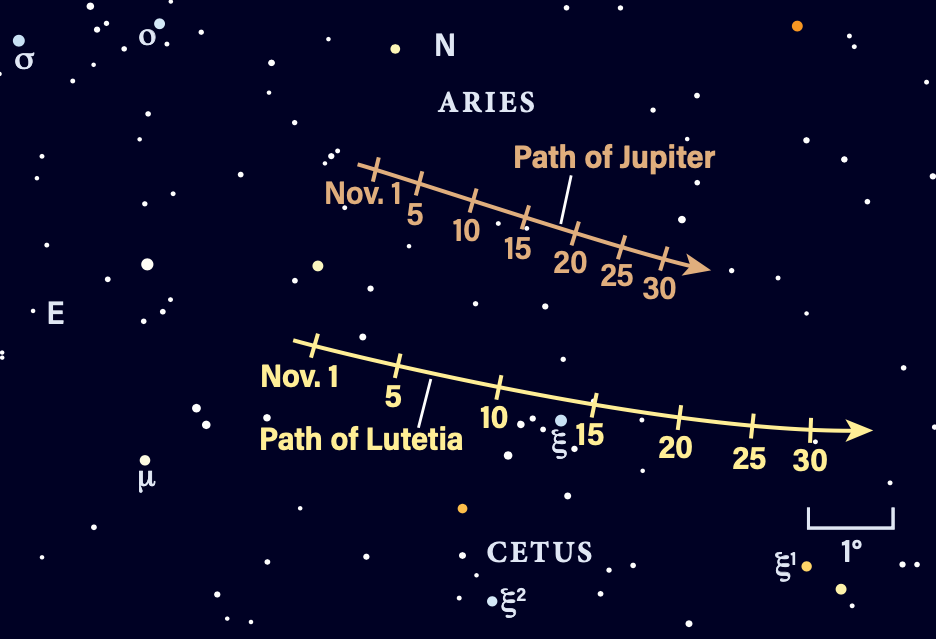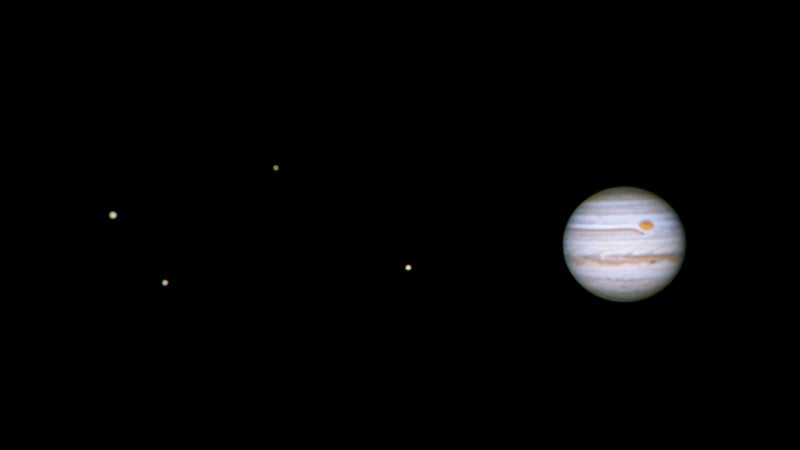
Saturn is already visible after dark while Jupiter is rising in the eastern sky, beckoning for attention all night. Uranus is at its best for the year and Neptune is also on display — more of a challenge, but with a helpful star nearby. Venus continues its brilliant predawn showing all month and can’t be missed, rising about four hours before the Sun.
Our planetary observing begins with the reappearance of Mercury in the evening sky. It’s a challenge due to its southerly declination, although lucky observers might spot it 5° to the right of a 38-hour-old crescent Moon Nov. 14 (you’ll need a clear southwestern horizon). Both stand 3° above the horizon 20 minutes after sunset and set quickly — you have about 10 minutes to spot them. Mercury glows at magnitude –0.5.
There’s gentle improvement as Mercury’s elongation from the Sun increases daily, reaching 20° east of our star on the 27th, when it sets an hour after the Sun. As November ends, Mercury stands 5° high in the southwest 30 minutes after sunset.
Saturn lies in the south as the sky darkens. Starting the month at magnitude 0.7 and standing 35° high for U.S. observers at midlatitudes, it outshines Fomalhaut, a bright star slightly east of the planet and halfway between it and the horizon. Saturn dims slightly to magnitude 0.8 in the third week of the month.
Saturn stops moving retrograde on the 4th and resumes an easterly trek across southern Aquarius. Its motion away from Iota (ι) Aquarii is barely noticeable until late November. The nearly First Quarter Moon stands within 10° of the planet on the 19th.
Saturn sets shortly before 2 A.M. local daylight time on the 1st and just before 11 P.M. local time on the 30th. Any telescope will reveal the rings. They span almost 40″ at their widest; the narrow axis is 6″. Brightest is Ring B, bounded by the dark Cassini Division and dimmer outer A Ring. The innermost C Ring is partly transparent.
The narrowing tilt of the rings over the past few years is revealing the planet’s southern hemisphere. Be on the watch for new features in Saturn’s normally hazy atmosphere. Subtle belts and zones are visible under steady seeing conditions.
Of Saturn’s moons visible in a small backyard scope, Titan is brightest. You’ll pick it up at magnitude 8.6, orbiting every 16 days. Find it roughly north of the planet Nov. 10 and 26, and roughly south Nov. 2 and 18.
Tethys, Dione, and Rhea are the next easily spotted moons at 10th magnitude. They lie inside Titan’s orbit and are joined by fainter Enceladus and Iapetus, all on the western side of the rings, on Nov. 7. Eleventh-magnitude Iapetus is at inferior conjunction and unusually close to the planet. It lies between Rhea and Dione. Magnitude 12 Enceladus is challenging in smaller scopes due to Saturn’s brilliance. It lies south of Dione in the early evening. Between 9 P.M. and 10 P.M. EST, these five moons curve around the western end of the rings. Watch this collection over an hour to see their relative motions upset the nice, smooth arc.
Tethys undergoes transits two nights apart, on Nov. 18 and 20. Both times it is followed by its shadow. It’s best to record such events with a high-speed video camera designed for planetary observation.
Tethys’ transit on the 18th begins around 11:35 P.M. EST and lasts nearly 80 minutes. On the 20th, the transit begins around 8:50 P.M. EST and lasts about the same duration. Plan to be observing 15 to 20 minutes before the start.
After inferior conjunction, Iapetus moves toward its brighter western elongation, which it reaches Nov. 27. At this location in its orbit, the moon is nearly 10th magnitude and stands 8.5′ west of the planet.
Neptune is visible much of the night in Pisces. Binoculars or a small scope will show the magnitude 7.7 planet, which lies more than 29 astronomical units (2.7 billion miles; 1 astronomical unit [AU] is the average Earth-Sun distance) from Earth. It sits 5° due south of 4th-magnitude Lambda (λ) Piscium. 20 Psc lies about 1.5° east-northeast of the planet, shining at 5th magnitude.
Neptune’s retrograde motion carries it back into northeastern Aquarius by the end of the month. A telescope will show the bluish, 2″-wide disk.
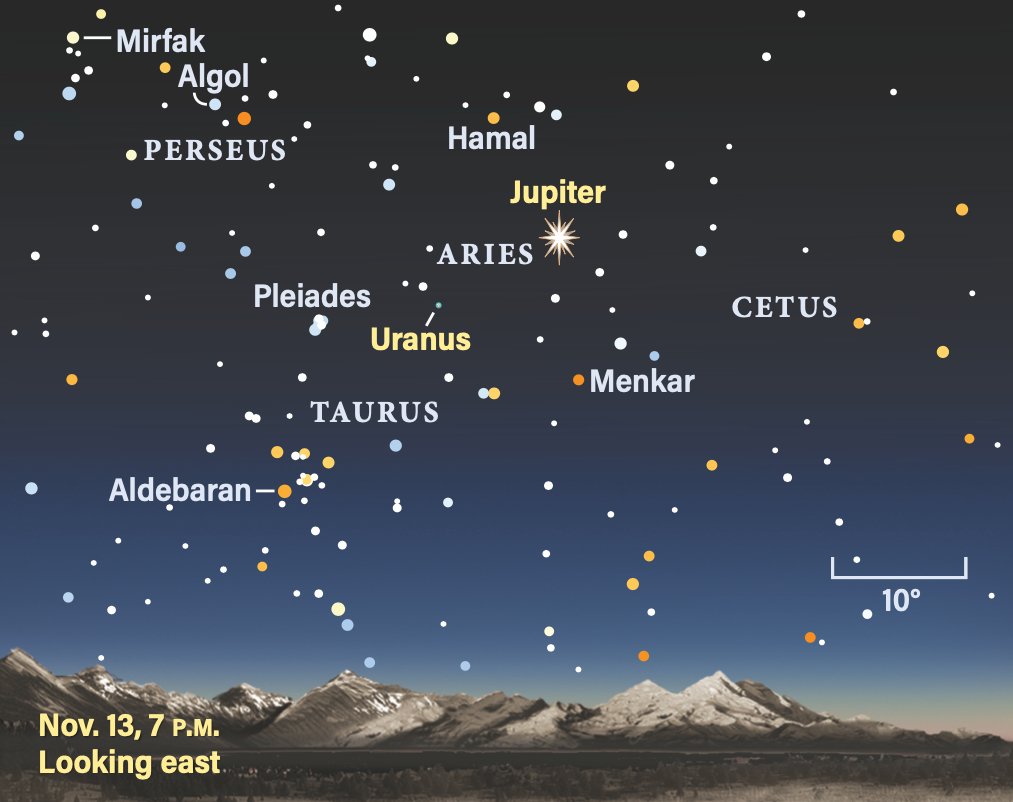
Jupiter is visible all night and reaches opposition Nov. 3. This is the best time of the year to observe the gas giant, now closest to Earth at 3.98 AU (370 million miles). It brightens the constellation Aries with its magnitude –2.9 glow. The planet’s apparent diameter reaches 49″ and shaves off barely an arcsecond during the rest of the month.
This large apparent size is a great benefit, particularly for observers using high-speed video. Jupiter is bright, shortening exposure times and allowing capture at a higher frame rate with good signal to noise. Shorter exposure times aid with freezing the blurring effects of our atmosphere in a bid to capture fine detail in Jupiter’s atmosphere.
Jupiter also climbs higher in the sky for northern observers than at any time since 2015. The higher elevation reduces the amount of Earth’s atmosphere that the planet’s light passes through. Add in the long nights of early winter and an entire rotation of Jupiter can be captured in less than 10 hours.
A telescope reveals the dark equatorial belts straddling the equator. The Great Red Spot makes regular appearances, visible for some time each night. Finer and more subtle details in the ever-changing cloud belts become noticeable with patient and prolonged viewing, as your eye becomes accustomed to the planet’s brilliance.
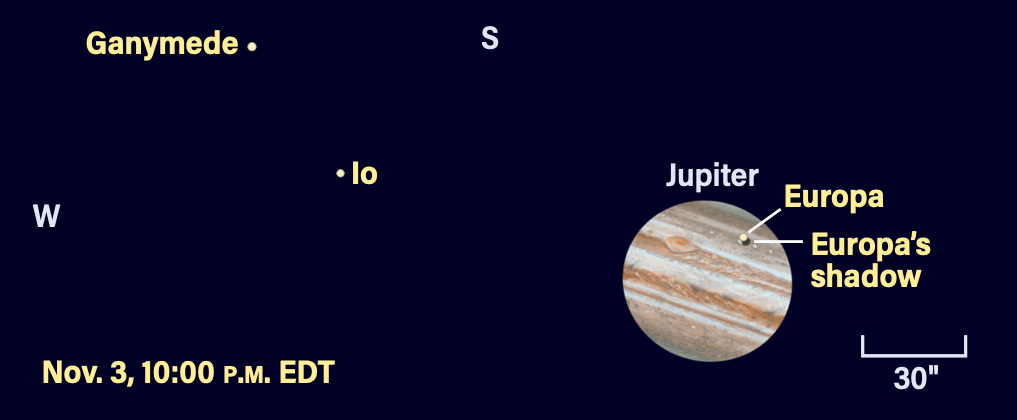
The Galilean moons also subtend a larger apparent diameter at opposition, aiding the recording of surface features with perfectly collimated telescopes and video capture. At opposition, transiting moons and their shadows nearly overlap, while later in the month you can see the same moon transiting with its shadow following later.
For example, three Io transits are visible on the evenings of Nov. 4/5, 11/12, and 20. Io and its shadow begin transiting within two minutes of each other on the 4th, starting at 11:55 P.M. EDT (note that daylight saving time ends at 2 A.M. on Nov. 5). On the 12th, Io’s transit begins at 12:38 A.M. EST (late on the 11th in all other time zones) and now the shadow lags by 14 minutes, appearing at 12:52 A.M. EST. On the 20th, Io begins a transit at 8:49 P.M. EST and the shadow follows 28 minutes later, at 9:17 P.M. EST.
Europa’s transits exhibit the same changing geometry. On Nov. 3, the night of opposition, the moon and shadow overlap. Europa’s transit begins at 9:15 P.M. EDT and its shadow appears one minute later.
By Nov. 10, Earth is about 7° farther along its orbit, and Europa and its shadow are well separated. Europa begins its transit at 10:29 P.M. EST, followed by the shadow 22 minutes later.
Ganymede undergoes a fascinating eclipse behind Jupiter’s northern limb beginning Nov. 6 at 10:44 P.M. EST. Due to the shallow angle of the limb, Ganymede will blend with Jupiter a few minutes earlier. While Ganymede ends the occultation just before 12 A.M. EST on the 7th (still firmly the 6th in other time zones), it’s in Jupiter’s shadow. The moon finally reappears around 12:26 A.M. EST, taking more than 10 minutes to fully emerge.
Ganymede undergoes a similar event Nov. 13/14, starting at 1:56 A.M. EST on the 14th (the 13th for the western U.S.), with shadow egress at 4:36 A.M. EST. Another interesting event occurs early on Nov. 21, best observed from the western half of the U.S. Ganymede disappears around 4:10 A.M. CST and reappears at 5:30 A.M. CST, when Jupiter is near the horizon in the Midwest. However, Ganymede remains visible only 24 minutes before entering Jupiter’s extended shadow in an eclipse that lasts nearly two hours, emerging at 5:37 A.M. PST, when Jupiter is extremely low on the West Coast.
Uranus reaches opposition Nov. 13, the second major planet to do so this month. It stands roughly midway between Jupiter and the Pleiades (M45). Scan the region with binoculars to find a small group of stars glowing between 4th and 6th magnitude. The brightest star in this region, 9.5° southwest of M45, is magnitude 4.3 Delta (δ) Arietis. Uranus sits roughly 2.2° south of this star all month. A nearly Full Moon lies in the same vicinity overnight on Nov. 24/25.
Uranus glows at magnitude 5.7, an easy binocular object. An interesting test of sky conditions is to see whether you can spot the planet with the unaided eye. You’ll need very dark skies away from any city lights.
During the month, Uranus moves about 1.2° westward along a retrograde path. At opposition it lies 18.6 AU (1.7 billion miles) from Earth and through a telescope reveals a tiny 4″-wide disk.
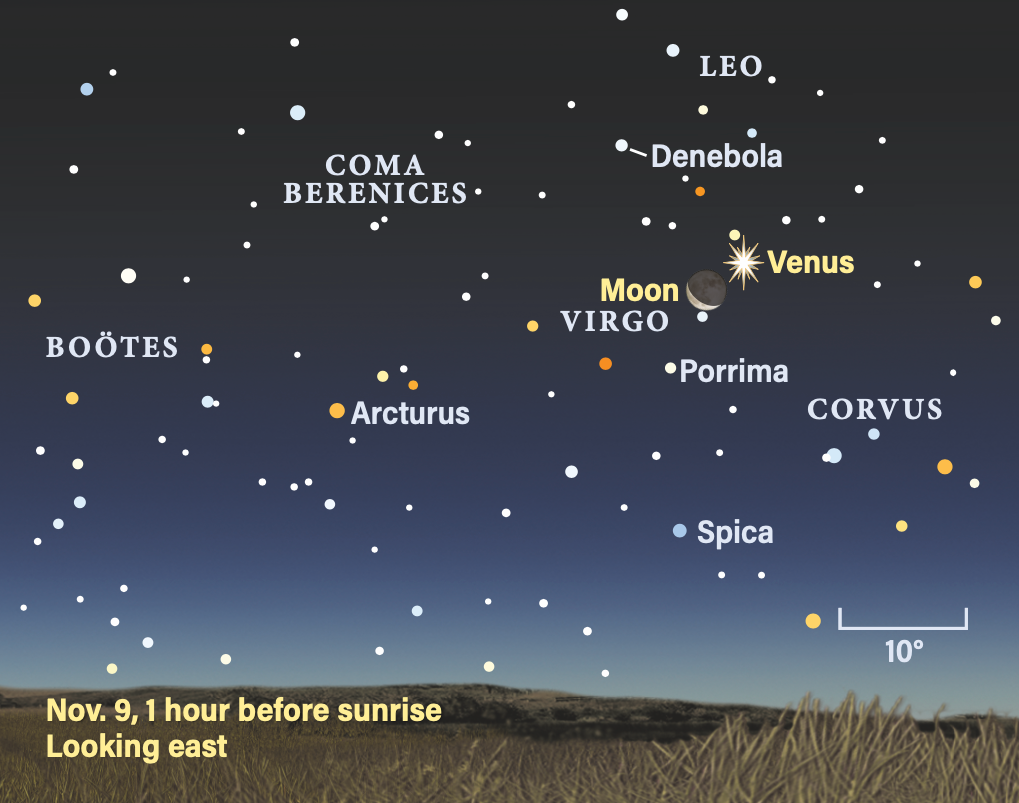
Venus is a brilliant morning star, rising 4 hours before the Sun and shining briefly at magnitude –4.4. It crosses from Leo into Virgo on the 3rd. The planet’s motion carries it from near Beta (β) Virginis on the 5th and 6th to a point 1.2° south of Porrima on the 18th. A crescent Moon hangs near Venus on the morning of Nov. 9.
Venus stands 5° north of Spica, Virgo’s 1st-magnitude star, on the 27th, and ends the month 4.3° northeast of this star. Following Venus through a telescope reveals its changing phase, from a slightly gibbous, 55-percent-lit disk on Nov. 1 to 67 percent lit by the 30th. At the same time, the disk shrinks from 22″ to 17″ across as it recedes from Earth.
Mars is too close to the Sun for observing this month and is in conjunction with the Sun on Nov. 18.
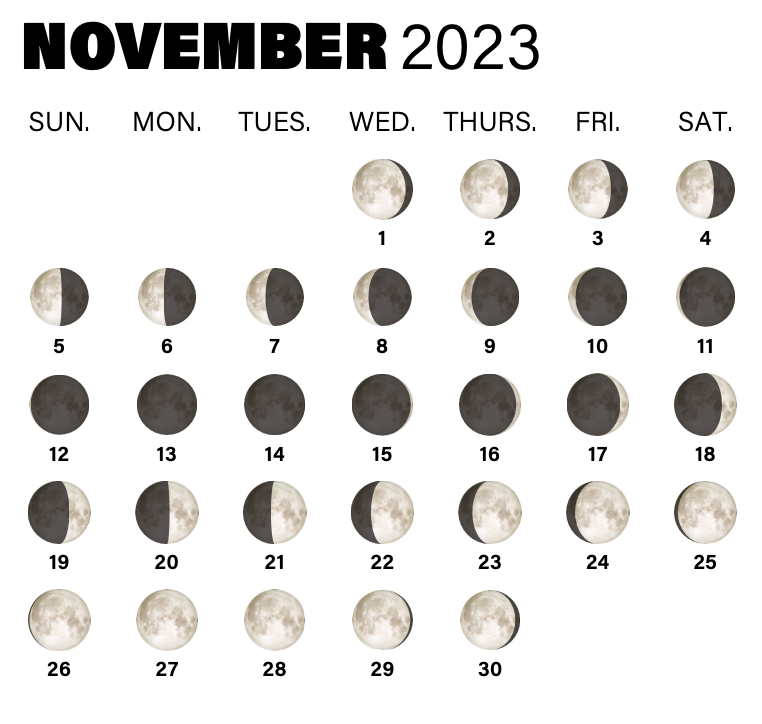
Rising Moon: The ghost ring
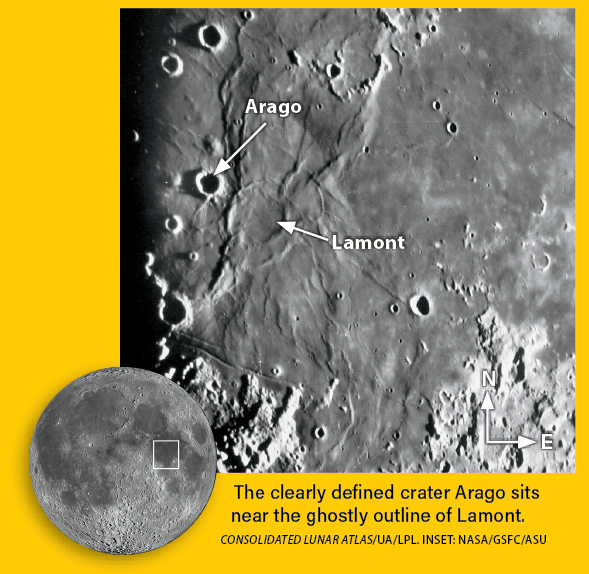
The waxing crescent Moon is a crowd pleaser and a selenophile’s delight. On the evening of the 18th, two nights before First Quarter, the bewildering spread of craters in the south gives way to the wrinkled ridges crossing the darker lava seas to the north. Pry your eye away from the fantastic Serpentine Ridge in the northern half of the Moon and settle on a spot just
above the equator, where a wild zone of ridges plies the frozen face of Mare Tranquillitatis.
Literally buried under the Sea of Tranquillity’s mostly north-south ridges is a ghostly ring named Lamont. Astronomers believe this is all that’s left of a modestly large impact basin, later flooded to the rim by the upwelling lavas of eons ago. Afterward, a smaller impactor carved out the crater Arago to the northwest. A second concentric ring, about twice the size of Lamont, is trickier to see and seems easier when you’re not trying hard. Multiple rings are a common feature of the larger basins. Just north of Arago is a modest bump, the largest of a family of volcanic domes in the neighborhood.
Both the wrinkles and domes are so gentle that without the low Sun angle they will disappear by the 19th. Should the 18th be cloudy, take your next opportunity and instead drift on any lunar sea near the terminator. Wrinkles, bumps, and cracks await!
Meteor Watch: Look to the Lion
This year’s annual Leonid meteor shower peaks Nov. 17/18 during nighttime across the U.S. It coincides with a five-day old crescent Moon that sets before 10P.M. local time. The Leonids are associated with Comet 55P/Tempel-Tuttle, which last reached perihelion in 1998.
In recent years, hourly rates have been declining and are not expected to improve for a few years. However, with so much planetary action going on (Jupiter is visible all night and Venus rises early), it’s a great time to add in a period of meteor observing.
Leo rises around local midnight and the radiant, located in the Sickle asterism, is visible through dawn. The hour before twilight is the best time for all meteor showers, placing us on the leading hemisphere of Earth as it flies into the stream of meteor debris. The Leonids are known to be very swift, and many meteors leave glowing, persistent trains, which are fascinating to experience. Look 40° to 60° away from Leo to spot the longest trails.
The shower is active from Nov. 6 to 30, so be on watch for Leonids for at least a week or two on either side of the peak date.
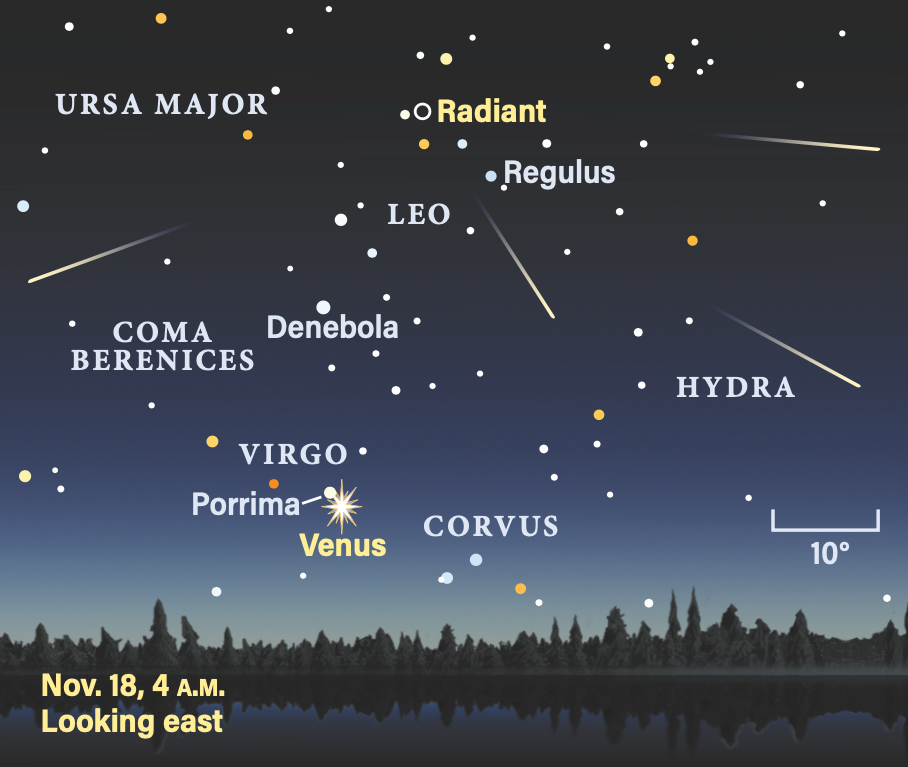
Comet Search: Catch the bees asleep
We’re treated for a whole week to Comet 62P/Tsuchinshan (also called Tsuchinshan 1) posing with M44 while the Moon is out of the sky. The only catch is that it’s not for evening or suburban observers. Plan to be outside the city, stay up past 1 A.M., and bring along at least a 4-inch scope to spy the 10th-magnitude fuzz.
There’s more to keep an eye out for: swift Leonids, fireball Taurids, and another half-dozen minor meteor showers. And by 2 A.M., the slightly brighter Comet 103P/Hartley climbs up just below Hydra’s head.
Imagers can expect to capture the classic green glow surrounding Tsuchinshan 1’s coma, since the comet is inside the orbit of Mars and close enough to the Sun. Consider using a 135mm telephoto lens to frame it along with the sparkly and colorful Beehive Cluster. Visually, the comet will remain gray, but what will the condensation be like? Diffuse with a bright core, or gradually brightening from the outside into the middle, reminiscent of many elliptical galaxies?
Don’t expect to see or image a tail this month, except for the slightest hint. Tsuchinshan 1 is traveling just off the ecliptic and close to opposition, so the physical tails are streaming behind it in the solar wind. Perihelion, its closest approach to the Sun, occurs Dec. 25, but outside Earth’s orbit.
Should the name Tsuchinshan sound familiar, this observatory co-discovered C/2023 A3 (Tsuchinshan–Atlas), which will catch media attention next October, perhaps cracking magnitude 0!
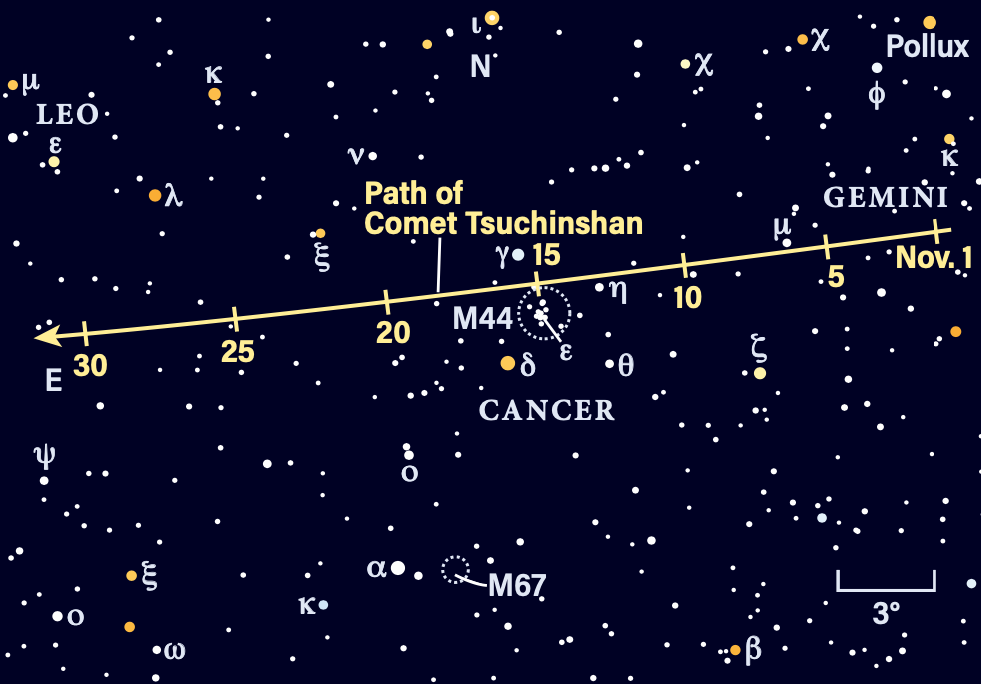
Locating Asteroids: Zeus points the way
When does an asteroid’s bright signpost move? When it’s a planet! All month, minor planet 21 Lutetia parallels the gas giant Jupiter’s movement, almost exactly 2° to the planet’s south.
Both come to opposition on the 3rd, lying opposite the Sun, when they’ll be highest in the sky just after midnight for most readers. Because Lutetia orbits in the main belt between Jupiter and Mars, it is closer to us and moves faster across the sky.
The Rosetta spacecraft visited the out-of-round, 60-mile-wide asteroid in 2010. With an albedo (reflectivity) of 20 percent, Lutetia is just brighter than 10th magnitude, which means you’ll need to be patient when tracking it down.
Drop down from Jupiter and match the pattern in the background stars to the view through your eyepiece, remembering that it might be upside down or flipped left to right. Make a quick sketch of the five brightest stars in the field, then come back a night or two later to see which dot moved. Just avoid the 24th through the 26th, when the Moon passes by.
